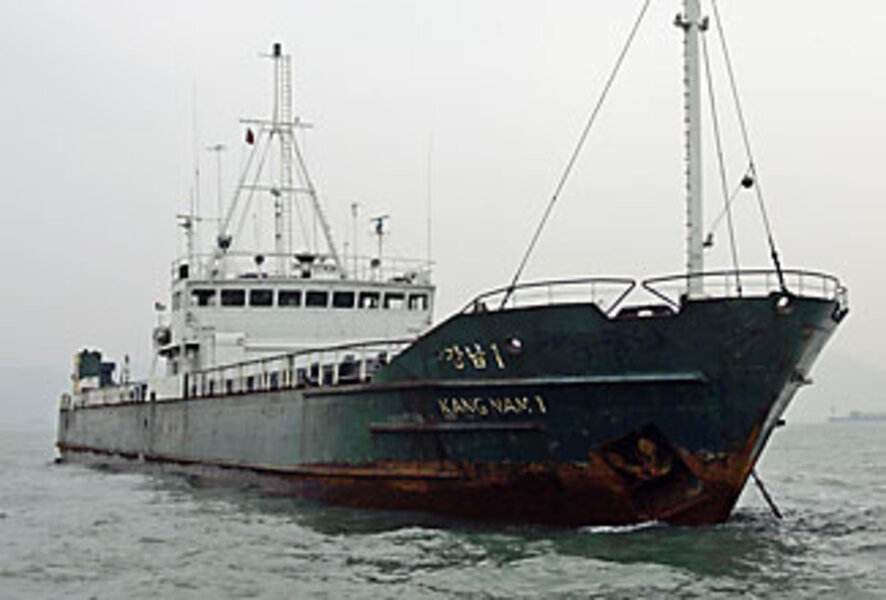US Navy well-versed in interdicting suspect cargo ships
Loading...
In January the amphibious transport USS San Antonio stopped a Russian-owned cargo ship, the Monchegorsk, in the Red Sea. US intelligence had received a tip that the freighter was carrying weapons exports from Iran – a violation of United Nations sanctions.
A US Navy boarding party confirmed the presence of arms. They directed the ship to Cyprus, where authorities impounded crates of Iranian-made mortar components, shell casings, and powder. US officials believe the cargo had been bound for Syria, perhaps for further distribution to the Palestinian militant group Hamas.
As this incident shows, the US Navy and allies have ample experience at interdicting suspect vessels on the high seas.
Currently, Navy warships are trailing the Kang Nam, a North Korean cargo ship suspected of carrying weapons bound for Myanmar (Burma).
The Kang Nam outcome remains uncertain. The new UN Security Council resolution that authorizes member nations to stop and inspect North Korean ships for illicit weapons does not authorize use of force.
But if it comes to boarding, the US should be ready. Maritime interception operations in search of pirates, terrorists in transit, and the occasional clandestine arms crate are increasingly a part of the Navy's weekly activities.
"They do this quite frequently off the Arabian peninsula, with varying degrees of intensity," says John Pike, director of GlobalSecurity.org.
A recent day at sea
Take a typical day at sea – in this case June 13, a day for which the Navy has posted a snapshot of ship movements.
On June 13, the cruiser USS Gettysburg turned over 17 suspected pirates to authorities in Mombasa, Kenya. The Gettysburg is serving as the flagship of Combined Task Force 151, the multinational organization established to fight piracy off the coast of Somalia.
Meanwhile, the destroyer USS John Paul Jones, patrol ship USS Sirocco, and Coast Guard ships Baranof, Monomoy, and Wrangell were working on maritime security operations in the northern Arabian Gulf, along with elements of the Iraqi Navy.
It's likely that the current level of deployment is similar. In addition, the destroyer USS John McCain (named for the senator's father and grandfather) is shadowing the Kang Nam in East Asia. According to wire service reports, the McCain is set to hand off its job to the destroyer USS McCampbell as the Kang Nam moves closer to the coast of Singapore.
Ready for resistance
As to the personnel involved in searches, the force dispatched depends on the expected level of resistance.
"It's a whole operational art," notes GlobalSecurity.org's Mr. Pike.
Take the USS San Antonio. Its crew includes a 14-person Navy visit, board, search and seizure (VBSS) team. It would also carry an eight-person Coast Guard Law Enforcement Detachment, a Marine sniper platoon, and intelligence personnel.
Special Operations personnel may also be involved in interdictions. According to Navy training documents, special ops might be called upon if a target ship has an above-water height of 25 feet or greater and if concerted resistance is expected.
How boarding happens
In general, boarding starts at the top. A boarding party takes control of the ship's bridge, begins an identity check of those onboard, and then searches lower in the vessel.
There are different ways to start at the top. Special forces teams are no doubt capable of simply free-handing down ropes from helicopters into the bridge.
In years past, North Korean ships have been stopped and searched in support of UN resolutions. In 2002, a North Korean freighter believed to be carrying missiles bound for Iraq was stopped and searched by Spanish warships.
Scud missiles were on board. But they were intended for Yemen, which was allowed under the resolutions then in place. The ship was allowed to proceed.





